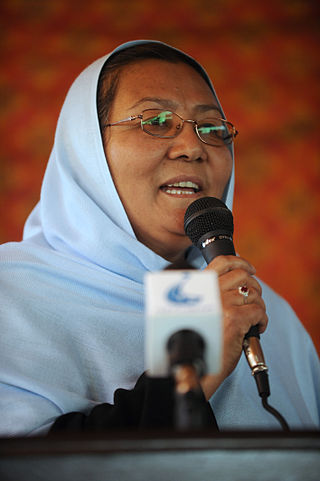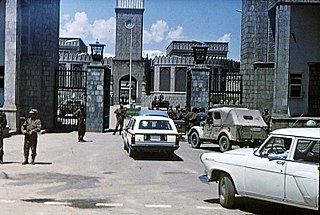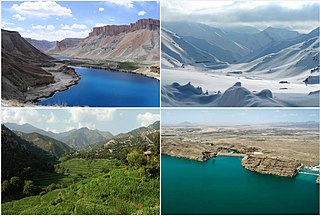Related Research Articles

The history of Afghanistan, preceding the establishment of the Emirate of Afghanistan in 1823 is shared with that of neighbouring Iran, central Asia and Indian subcontinent. The Sadozai monarchy ruled the Afghan Durrani Empire, considered the founding state of modern Afghanistan.

Kabul is the capital and largest city of Afghanistan. Located in the eastern half of the country, it is also a municipality, forming part of the Kabul Province; it is administratively divided into 22 municipal districts. According to 2023 estimates, the population of Kabul was 5 million people. In contemporary times, the city has served as Afghanistan's political, cultural, and economical center, and rapid urbanisation has made Kabul the 75th-largest city in the world and the country's primate city.

Abdul Ali Mazari (Dari: عبدالعلی مزاری; 1946 – March 13, 1995) was an ethnic Hazara politician and leader of Hezb-e Wahdat during and following the Soviet–Afghan War, who advocated for a federal system of governance in Afghanistan. He was allegedly captured and killed by the Taliban during negotiations in 1995, and posthumously given the title "Martyr for National Unity of Afghanistan" in 2016 by the Afghan government.

Bamyan Province also spelled Bamiyan, Bāmīān or Bāmyān is one of the thirty-four provinces of Afghanistan with the city of Bamyan as its center, located in central parts of Afghanistan.

The culture of Afghanistan has persisted for over three millennia, tracing record to at least the time of the Achaemenid Empire in 500 BCE, and encompasses the cultural diversity of the nation. Afghanistan's culture is historically strongly connected to nearby Persia, including the same religion, as the people of both countries have lived together for thousands of years. Its location at the crossroads of Central, South and Western Asia historically made it a hub of diversity, dubbed by one historian as the "roundabout of the ancient world".

Dr. Habiba Sarābi is a hematologist, politician, and reformer of the reconstruction of Afghanistan after the Taliban first took power. In 2005, she was appointed as Governor of Bamyan Province - the first Afghan woman to become a provincial governor. She had served as Afghanistan's Minister of Women's Affairs and as Minister of Culture and Education. Sarabi was instrumental in promoting women's rights and representation and environmental issues. She belongs to the ethnic Hazara people of Afghanistan. Her last name is sometimes spelled Sarobi.

Shirin Neshat is an Iranian visual artist who lives in New York City, known primarily for her work in film, video and photography. Her artwork centers on the contrasts between Islam and the West, femininity and masculinity, public life and private life, antiquity and modernity, and bridging the spaces between these subjects.

Abdul Haq was an Afghan mujahideen commander who fought against the Soviet-backed People's Democratic Party of Afghanistan, the de facto Afghan government in the 1980s. He was killed by the Taliban in October 2001 while trying to create a popular uprising against the Taliban in Afghanistan in the wake of the September 11th attacks.

Cinema was introduced to Afghanistan at the beginning of the 20th century. Political troubles slowed the industry over the years; however, numerous Pashto and Dari films have been made both inside and outside Afghanistan throughout the 20th century. The cinema of Afghanistan entered a new phase in 2001, but has failed to recover to its popular pre-war status.

Alighiero Fabrizio Boetti known as Alighiero e Boetti was an Italian conceptual artist, considered to be a member of the art movement Arte Povera.

The Saur Revolution or Sowr Revolution, also known as the April Revolution or the April Coup, was staged on 27–28 April 1978 by the People's Democratic Party of Afghanistan (PDPA) and overthrew Afghan president Mohammed Daoud Khan, who had himself taken power in the 1973 Afghan coup d'état and established an autocratic one-party system in the country. Daoud and most of his family were executed at the Arg in the capital city of Kabul by PDPA-affiliated military officers, after which his supporters were also purged and killed. The successful PDPA uprising resulted in the creation of a socialist Afghan government that was closely aligned with the Soviet Union, with Nur Muhammad Taraki serving as the PDPA's General Secretary of the Revolutionary Council. Saur or Sowr is the Dari-language name for the second month of the Solar Hijri calendar, during which the events took place.

Located on the strategic crossroads of Iran, India, China and Central Asia, Afghanistan boasts a diverse cultural and religious history. The soil is rich with archaeological treasures and art that have for decades come under threat of destruction and damage. Archaeology of Afghanistan, mainly conducted by British and French antiquarians, has had a heavy focus on the treasure filled Buddhist monasteries that lined the silk road from the 1st c. BCE – 6th c. AD. Particularly the ancient civilizations in the region during the Hellenistic period and the Kushan Empire. The world's oldest-known oil paintings, dating to the 7th c. AD, were found in caves in Afghanistan's Bamiyan Valley. The valley is also home to the famous Buddhas of Bamiyan.

Tourism in Afghanistan is regulated by the Ministry of Information and Culture. There are at least 350 tourism companies operating in Afghanistan. Tourism was at its peak before the 1978 Saur Revolution, which was followed by the decades of war. Between 2013 and 2016, Afghan embassies issued between 15,000 and 20,000 tourist visas annually.

Nancy Hatch Dupree was an American-Afghan historian whose work primarily focused on the history of modern Afghanistan. She was the director of the Afghanistan Center at Kabul University and author of five books that she compiled while studying the history of Afghanistan from 1962 until the late 1970s, writing about tourism and history of Bamyan, Kabul, Kandahar, Herat, Mazar-i-Sharif and so on. She was fondly called the "grandmother of Afghanistan", having spent more of her life there or with Afghans abroad.

Afghan art has spanned many centuries. In contrast to its independence and isolation in recent centuries, ancient and medieval Afghanistan spent long periods as part of large empires, which mostly also included parts of modern Pakistan and north India, as well as Iran. Afghan cities were often sometimes among the capitals or main cities of these, as with the Kushan Empire, and later the Mughal Empire. In addition some routes of the Silk Road to and from China pass through Afghanistan, bringing influences from both the east and west.
Afghanistan is uniquely situated as a throughway of cultures throughout its history due to it geographic placement in South Asia. Afghanistan's location lends porous borders to trade routes between the East and West, while the Silk Road providing a vector for Buddhism and Hellenistic culture and even Egyptian influences from the west, renders an amalgamation of culture and art. Perpetual invasion and conflict has rendered a cyclic continuum of renaissance and destruction of art and culture in Afghanistan.

Shamsia Hassani is an Afghan graffiti artist, a fine arts lecturer, and the associate professor of Drawing and Anatomy Drawing at the Kabul University. She has popularized "street art" in the streets of Kabul and has exhibited her art in several countries including India, Iran, Germany, United States of America, Switzerland, Vietnam, Norway, Denmark, Turkey, Italy, Canada, and in diplomatic missions in Kabul. Hassani paints graffiti in Kabul to bring awareness to the war years. In 2014, Hassani was named one of FP's top 100 global thinkers. She was recognized as one of the BBC's 100 women of 2021.
Hale Tenger is a visual artist based in Istanbul. She is known for her large-scale installations that explore identity, collective memory, and political violence. Using sculpture, video, and sound, her work has been exhibited at numerous public institutions, including Arthur M. Sackler Gallery, Smithsonian Institution, Washington DC.; Martin-Gropius-Bau and Kunst-Werke, Berlin; Kunstmuseum Bonn, Bonn; Fridericianum, Kassel; New Museum, New York; Witte de With Center for Contemporary Art and Museum Boijmans Van Beuningen, Rotterdam; Palais des Beaux-Arts de Lille, Lille; Carré d’Art-Nimes Museum of Contemporary Art, Nimes; Thyssen-Bornemisza Art Contemporary, Vienna; Seoul Museum of Art, Seoul; Van Abbemuseum, Eindhoven; ZKM, Karlsruhe; Centre d’Art Contemporain Genéve, Geneva; Nikolaj Contemporary Art Center, Copenhagen; Museum voor Moderne Kunst Arnhem, Arnhem; Istanbul Modern and ARTER, Istanbul.
Leeza Ahmady is an Afghan-born American independent curator, author, arts administrator, dance instructor, and educator; she is known for her work within the genre of Central Asian art. She is the founder of AhmadyArts and Director of Asia Contemporary Art Week (ACAW) since 2006. Ahmady has organized large-scale festivals, exhibitions, artistic collaborations, and experimental forums revolving around contemporary art practices from across all regions of Asia. Ahmady is New York based and was born and raised in Kabul, Afghanistan.
Khadim Ali is an Australian painter of Afghan descent, a member of the Hazaras ethnic group.
References
- ↑ ArtFacts.net. "Lida Abdul." ArtFacts.net. Accessed April 05, 2017. http://www.artfacts.net/en/artist/lida-abdul-38414/profile.html .
- 1 2 Reilly, Maura; Nochlin, Linda, eds. (2007). Global feminisms: new directions in contemporary art. London: Brooklyn Museum. ISBN 978-1-85894-390-9. OCLC 79256724.
- 1 2 3 4 5 6 "Lida Abdul." Guggenheim. Accessed February 08, 2017. https://www.guggenheim.org/artwork/artist/lida-abdul .
- 1 2 3 4 5 6 7 Olson, Christopher (May 2008). "Lida Abdul". Border Crossings. Winnipeg. 27 (2): 90–92. ProQuest 215549787.
- 1 2 3 Franklin, Paul B (June 2014). "Paris: Lida Abdul". Art in America. 102 (6): 170–171.
- 1 2 3 4 5 6 7 8 9 Collins, Joseph J. The Soviet Invasion of Afghanistan: A Study in the Use of Force in Soviet Foreign Policy. Lexington (Mass.): Lexington Books, 1987
- ↑ Spanier, Samson. "Venice Biennale news: several countries are exhibiting at the Biennale for the first time this year, says Samson Spanier. But the important things--champagne and politics--have not changed." Apollo, July 2005
- ↑ Balzer, David (March 2007). "Paint it white: Afghani artist Lida Abdul chronicles her homeland's struggle to rebuild". Toronto Life. 41 (3): 113.
- 1 2 3 4 MacGilp, Alexandra. "White House." ArtAsiaPacific: Lida Abdul. November/December 2013. Accessed February 08, 2017. http://artasiapacific.com/Magazine/86/LidaAbdul .
- 1 2 3 Cateforis, David; Dusenbury, Mary (May 2006). Lida Abdul – White House , 2005. University of Kansas. hdl: 1808/13872 .
- 1 2 3 MacGilp, Alexander. "White House Lida Abdul". Artasiapacific. Archived from the original on 5 May 2015. Retrieved 13 April 2017.
- ↑ "Lida Abdul". www.giorgiopersano.org. Kabul. Retrieved 13 April 2017.
- ↑ Robinson, Hilary. Feminist Art History; An Anthology 1968-2014. pp. 482–486.
- 1 2 Hammond, Thomas Taylor. Red Flag over Afghanistan: The Communist Coup, the Soviet Invasion, and the Consequences. Boulder, CO: Westview Press, 1984, pg. #5.
- 1 2 3 Gorce, Tammy La (30 March 2014). "Despite Conflict and Repression, Creativity". The New York Times.